St. Mary's Catholic Church
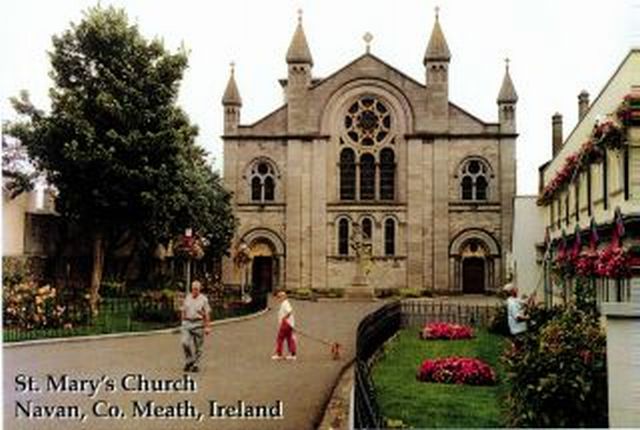
Photo Bernard McCluskey
During the Penal days, the only place the Catholics in the town of Navan had to worship in was a little mud walled chapel in Leighsbrook. On Christmas Day 1772 this little chapel at Leighsbrook crumbled and the roof fell in. For many months after this, Mass was celebrated in a yard off Trimgate Street with a sentry box providing shelter for the priest. A mud walled thatched house was then erected on the site of the present church.
The local farmers used this building during the week as a barn for theshing corn and on Saturday night the local boys swept the floor and prepared it for Sunday. The door was taken off its hinges and placed on two barrels to serve as an altar. This served as a church for nine years.
The Penal Law against Catholic belfries was rigorously enforced at this time. To evade the law, a bell was erected along the side wall of a neighbouring brewery. This was Mark Martin's in Bakery Lane and the bell continued in use up to 1858. The bell summoned parishioners to worship on Sunday and to summon people to work on weekdays.
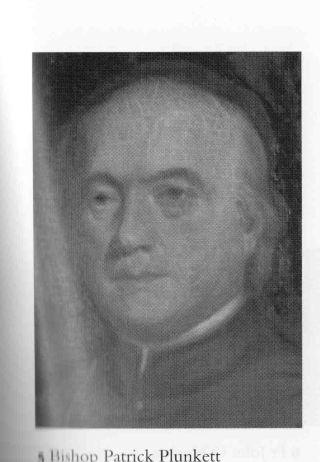
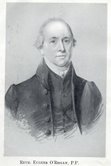
On 30th July 1796 Bishop Plunkett (above left) signed a lease from Peter Earl Ludlow for the site of the chapel for a period of 61 years and a new church was built.
By 1830 the newly appointed parish priest, Father Eugene O'Reilly, (above right) decided that a larger church was needed. He had been to Paris and was very impressed by the interior of the Metropolitan Opera House.
His church was modelled on it. "I will build a church that will hold 3000, where everyone can see and hear the priest," he is reported to have said. So a gallery was built all around the church (in 1847) to bring the congregation closer to the altar so that everyone could see and hear the priest.
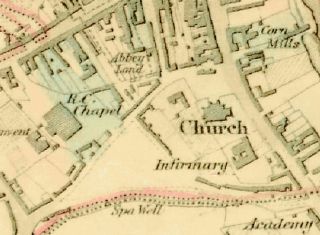
The present St. Mary's Catholic Church is marked as R.C. Chapel. Although the 1837 O.S. map illustrated here predates the Church by 2 years we can assume the basic shape of the church had taken form, and was recorded by the map makers.
A local farmer from Clowanstown near Skryne, Thomas Maher offered Fr O' Reilly £50 if he started a new church but not a ha'penny if he didn't. Subscriptions came on from Protestants and Catholics alike, and within months £600 had been raised. 48 stonemasons offered a fortnight's free labour, farmers gave the use of their horses and carts to haul gravel from Athlumney; the curate Fr McAlroy collected £470 from exiles in England, and so the new church began with Mr Bulger as architect and Mr Madden as foreman.
By the time of its opening in 1839 £4000 had been spent on the building, and a further £2000 would be needed to complete the interior.
Fr O'Reilly did not forget the past. The Edward Smyth Crucifix of the old church became the Crucifix of the new one. Above all, the patron of the new church was that of the old Abbey - St. Mary or Our Lady under her title of the Assumption. He was laying continuity between his new church and the old Abbey church founded 700 years before.
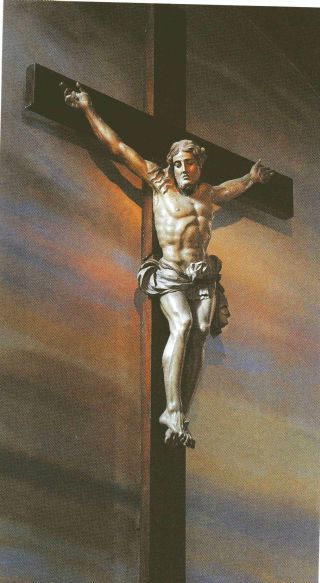
Edward Smyth , a Meathman, and possiblly a Navan man was one of Gandon's sculptors who worked with him on the riverine sculptures on the Custom House Dublin. His Crucifix is carved from lime wood -his only known work in wood (right)
There is an inscription on the back
" EDW SMYTH - DUBLIN - sculpt - 1792. "
The galleries were installed in 1847 and the bell in 1858.The high altar was added as a memorial to Dean Anthony Cogan (1826-1872) the Historian of the Diocese, and author of the seminal "History of the Diocese of Meath Ancient and Modern" in 3 vols.
Above the altar are the images of the Four Evangelists by Richard King which are rich in colour.
*******
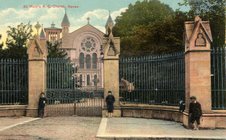
Other Features of St. Mary's:
1. The piers and gate on the Trimgate Street side came from Dangan Castle, Summerhill.
2. The stone crucifix on the the Trimgate St. side was sculpted by Thomas Curry of Navan.
3. The marble fonts inside, on the Trimgate Street side, were presented to Father J.J. Poland, Administrator, by E and M. S heridan, Newbridge, Navan who built the Abbey School, run by the De La Salle brothers (now demolished).
4. Two candle shrines on the Trimgate Street side.
"In memory of James and Kate Sheridan, Market Square, Navan and their deceased relatives, 1938." Presented by Navan Pioneer Total Abstinence Society, April 1928.
5. Plaque inside the door on the Trimgate Street side in memory of Father William
McCormack teacher at the old St Finian's.
Father William McCormack 1805 - 1879.
There is a tablet on the wall immediately to the left when you enter St. Mary's Church from the Trimgate Street side. The inscription which is:
"He was born in the townland of Bishopstown in the Catholic parish of Killare - otherwise Ballimore, County Westmeath. He was ordained priest in Maynooth in 1829. In 1832 when there was an outbreak of cholera in the Diocese, Father William was one of the priests who volunteered to minister to the sick. Having served as a Curate in various parishes he was appointed to the staff of St. Finians Seminary, Navan, where he taught until his death."
6. St. Joseph's Altar on the Trimgate Street side: erected by John O'Neill of Navan and his neice under the auspices of Bishop Nulty.
7. Main Altar in memory of Rev. Anthony Cogan, Historian of the Diocese of Meath 1823 - 1878.
8. Side Altar, Trimgate Street side. Most Rev. Patrick Plunkett, Bishop of Meath. 1778 - 1827.
9. Over the High Altar. The painting of the Holy Land landscape is by Navan artist Patrick Reel.
10. Two Fonts at Fairgreen side. N.D. Kelly who died A.D. 1885.
11. Chapel of Perpetual Adoration Jerome and Esmy Morrissey and their deceased children.
12. Stations of the Cross Presented by Eliza Brady, Market Square.
13. Automatic Bell Toller Fitted on Sunday 16 -10-1953 by George Donohoe, Navan.
15. The Belfry- Built by contractor William Curry, brother of Thomas Curry who
sculpted the Cross in the Church grounds.
*******
20th Century Restoration Work on St. Mary's Church
Fr. Andy Farrell
Early in summer 1970 it was proposed to paint the parish church of St. Mary's in Navan.
Before beginning the work it was thought advisable to have a structural examination of the building carried out. A previous examination of the building in 1945 had guaranteed its safety for 25 years.
An architect's inspection now showed serious dangerous structural weakness in the roof. A new roof was recommended. Besides, many other repairs and improvements in a church which was showing the wear and tear of almost a century and a half were needed.
On January 19, 1972 the work of renovation began. A flat temporary roof of waterproofed chipboard was laid on scaffolding under the existing roof. As the slates were stripped away and the old roof timbers were revealed the over riding thought was of the heroic scale of the work carried out in the 1830s by men who stood on pole and lash scaffolding and hauled these massive timbers to those dizzying heights with tripod, rope and pulley.
When the existing walls were capped with a wide band of reinforced concrete, the preconstructed steel trusses like giant As were lifted into position, bolted to the wall on one side, resting unbolted on expansion plates on the other. These trusses were next ribbed with rafters of treated timber and covered with felt under blue Bangor slates. A tiled acoustic ceiling was then installed. Meanwhile the opes for four new doors were being broken. The plastering and rewiring of the entire church was proceeding and the rearrangement of the Sanctuary, Baptistry and Mortuary to meet new liturgical requirements was being carried out.
From the beginning it was known that the organ would have to be rebuilt. This organ was originally installed about 1847. Its original situation was on the gallery on the Fair Green side close to the sanctuary wall. In 1921 it was rebuilt by the firm of Chesnut and Company, Waterford, in the centre gallery position facing the altar. By dividing the pipes and rebuilding them on two brackets above the gallery on the east wall and locating the console in the nave, seating accomodation for 75 persons was made available in the space which the organ formerly occupied. In rebuilding this beautiful old instrument the Irish Organ Company made every effort to preserve its mellowness of tone. The former pneumatic action was replaced by electric action and an open diapason was added, increasing volume without distorting tone or quality of sound in any way.
The Stations of the Cross were another link with the past, irreplacable from the point of view of sentiment and local piety, but obscured by the passage of time and looking ungainly in their former framing and hanging. Mr Moss of the National Gallery advised that they were of considerable artistic value. The generousity of a parishioner made it possible to restore them and now newly framed and panelled on to the walls, they portray the Passion and Death of Christ with a realism, a quiet dignity and eloquence which more modern versions of the stations of the cross seem to lack.
Besides the two scriptural texts formerly inscribed in embossed plaster above the high altar have now been painted on canvas by Navan artist Patrick Reel. Since they are crucifixional texts the artist has made them relate by colour, texture and framing to the newly restored stations.
The main arch above the high altar is occupied by the famous Edward Smyth crucifix. This crucifix, the only piece of religous sculpture of note in Ireland dating from the 18th century, commissioned in 1791 by the people of Navan for the church which preceeded the present one, is now a national treasure. Examination of the figure on the crucifix by experts in the National Gallery revealed that several coats of plaster and paint had been overlaid on the original. Two years of patient work by restorers using modern techniques were required to strip away all the overlay and to reveal the dramatic and very beautiful sculture and painting executed by Smyth.
During the renovation the bust and plaque commemorating Father Eugene O'Reilly who founded the church was cut back to better proportions and cleaned and relettered. Another plaque commemorating Father William (Gull) McCormack, a former professor in the old St. Finians College who died in 1879 has a certain interest in that it was sculpted by Padraig Pearse's father.
A happy result of the removal of the heavy wooden trusses of the old roof has been the revealing of the upper circular portion of the west window on the parochial house side. The window presented in 1896 by the Loretto Sisters to Bishop Nulty on the occasion of his fiftieth anniversary as a priest and the two smaller windows on the Parochial House side are painted Munich glass. Mayer & Co. of Munich is a famous German stained glass design and manufacturing company, based in Munich, Germany, that has been active throughout most of the world for over 150 years. The work of Franz Mayer & Co. in churches throughout Ireland is currently the subject of graduate research at Trinity College Dublin. Mr. Mayer's daughter, travelled to Ireland with her father, and ended up marrying a son of Edward Crinion of the Central Hotel in Navan.
Another happy result of the higher, brighter roof is the rediscovery of the paintings of the Four Evangelists by Richard King. These four paintings with the two spandrels, one with a labarum, the other with a monogram of Our Lady were painted in oils on canvas for Dr. Dunne the parish adminitrator in 1950.
The requirements of the new liturgy determined the rearrangements of the sanctuary. The beautifully proportioned old high altar and pulpit were retained because of the attachment of the people to them. The corelation of the altar, ambo, president's chair, baptismal font and altar rails by the use of Sienna green marble is artistically good and makes a liturgical point.
With the repainting of the whole church, the cleaning of all the marble, the reburnishing of brasses, the finishing of the organ in oak face panelling, the upholstering of chairs and pridieus and the carpeting of the entire sanctuary, the renovation work was complete at acost of £100,000 one year and six weeks from the date of beginning.
In the work of renovation a conscious effort was made to retain the character of the church that Father Eugene O'Reilly set out to build in 1839. This church was built on the site of a mudwall thatched house which was used by the neighbouring farmers during the week as a barn for theshing corn. For eight years it was prepared on Saturday nights for Mass on Sunday by having one of its doors unhinged and laid across two barrels to serve as an altar. This mass house had replaced the little mudwall penal chapel which was erected in Leighsbrook during the early days of the reign of Queen Anne and which collapsed on Christmas night in 1772 having served for the dark years of Ireland's history as the impoverished successor to the ancient and long suppressed Monastery of St. Mary, Abbeylands, the parish church of Navan.
Bishop John McCormack formally reopened the renovated church on Sunday 25th February 1973.
*******
Navan Parish Catholic Clergy
A Short History of the Parishes of the Diocese of Meath, (1939), J. Brady
Parish Priests:
1781 - 1827~ Bishop Patrick Joseph Plunkett
1827 - 1852~ Father Eugene O'Reilly
1830 - 1866~ Bishop John Cantwell
1866 - 1898~ Bishop Thomas Nulty
1899 - 1906~ Bishop Matthew Gaffney
1906 - 1928~ Bishop Laurence Gaughran
1929 - 1943~ Bishop Thomas Mulvany
1943 - 1946~ Bishop John d'Alton
1947 - 1966~ Bishop John Kyne
1968 - 1990~ Bishop John McCormack
1990 - ~ Bishop Michael Smith
Administrators:
From 1852 the Bishop of Meath is the Parish Priest of Navan. The parish has an Administrator in charge. Administrators are subsequently appointed Parish Priest in another parish.
1853 - 1857~ Rev. Philip Callary PP Slane
1857 - 1867~ Rev. Patrick Blake, died PP Longwood
1867 - 1870~ Rev. Nicholas Keena, died PP Kilskyre
1870 - 1875~ Rev. Rev. Hugh Behan, died PP Tullamore
1875 - 1879~ Rev. Walter Connolly, died CC Athboy
!879 - 1889~ Rev. Dermot Cole, died PP Killucan
1889 - 1892~ Rev. Rev. Michael Woods, died PP Trim
1892 - 1899~ Rev. Peter McNamee, died PP Castletown Goeghegan
1899 - 1902~ Rev. Denis Flynn, died PP Kells
1902 - 1907~ Rev. Patrick Flanagan, died PP Summerhill
1907 - 1908~ Rev Patrick Farrell, PP Ballivor
1908 - 1918~ Rev. James Poland, PP Rathkenny
1918 - 1925~ Rev. Nicholas Cooney, died PP Kinnegad
1925 - 1928~ Rev. John O'Reilly, PP Collinstown
1928 - 1928~ Rev. John O'Connor, PP Kilcormac
1928 - 1928~ Rev. James Gilmore Born Mullingar 25th October, 1886. Educated at St. Finians and the Irish College, Rome. Ordained 8th June 1913. Catholic Curate (CC ) Ratoath and Kilmessan. Administrator Navan 23rd April 1928. Died 16th June 1928. Buried in Kilmessan
1928 - 1936 ~ Rev. John Kilmartin, PP Drumconrath
Educated at St. Finian's and Maynooth. Ordained 6th July, 1919. CC Mountnugent, Multyfarnham, Ardcath, Kilbeg, Lobinstown and Navan
Navan Parish Curates:
Riocht na Midhe, 2015, Navan Parish Curates. Page 221:
1851 - Fr. Jones, Navan’s C.C. argued that labourer’s insecurity, in terms of employment and housing was comparable to that of tenants. He called for intervention by the State and by the landlords in support of the comfort and security of those workers. The Nation, 1 March, 8 March 1851.
1857 - 1867~ Christopher Morgan. died Parish Priest Kilcormac
1864 - 1867~ Michael Kelly
1866 - 1873~ Peter Kelly, died Parish Priest, Slane
1867 - 1870~ Hugh Behan, died Parish Priest Tullamore
1869 - 1873~ Edward Horan, died Parish Priest Rathkenny
1871 - 1873~ James O'Neill, died Parish Priest Dunshaughlin
1873 - 1875~ John O'Connell
1873 - 1880~ Michael Woods, died Parish Priest Trim
1876 -
1874 - 1877~ Patrick Murtagh, died Parish Priest Collinstown
1879 - 1885~ Philip Callery
1885 - 1892~ Peter McNamee, died Parish Priest Castletown Geoghegan
1891 - 1899~ Denis Flynn, died Parish Priest Kells
1892 - 1907~ Patrick Farrell, died Parish Priest Ballivor
1899 - 1900~ Denis Coyne, died Parish Priest Clonmellon
1900 - 1901~ Thomas Shaw, died Parish Priest Lobinstown
1901 - 1901~ James Poland, Parish Priest Rathkenny
1901 - 1902~ John O'Callaghan, died Curate, Kells
1903 - 1903~ James O'Reilly, died Curate, Kilcormac
1903 - 1904~ Joseph Kelly, Parish Priest, Castlepollard
1904 - 1905~ Patrick Casey, died Parish Priest Ballinabrackey
1905 - 1906~ John Macken, died Administrator Mullingar
1906 - 1907~ Parish Priest Slane
1907 - 1912~ Thomas Shaw
1907 - 1928~ John O'Connor, Parish Priest, Kilcormac
1907 - 1915~ Edward Flynn, Parish Priest, Donore
1912 - 1925~ John O'Reilly, Parish Priest, Collinstown
1915 - 1918~ Nicholas Cooney, died Parish Priest, Kinnegad
1918 - 1928~ John Kilmartin, Parish Priest, Drumconrath
1918 - 1919~ Joseph Donegan, Curate, Drogheda
1925 - 1934~ James Nangle, Parish Priest, Carnaross
1928 - 1936~ Patrick Mulvany
1928 - 1929~ William Kiernan, Curate, Tubber
1929 - 1930~ Denis Mulvin, Administrator, Mullingar
1929 - 1930~ Hugh Dunne
1930 - 1934~ Patrick Logue
1934
Sources:
The Diocese of Meath Ancient and Modern, Vols. 1-3, Dean Anthony Cogan
A Short History of the Parishes of the Diocese of Meath, Rev. John Brady
Navan Parish - a Celebration of our Faith History, Jubilee Year 2000 publication
Articles on the History of Navan, Rev. Gerard Rice, Meath Chronicle, Feb/Mar 1981